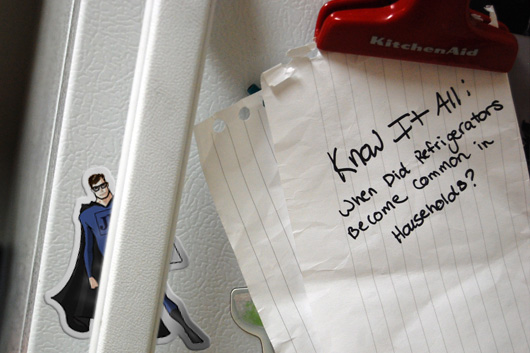By Justin Brown
Everybody has that moment when they realize they don’t know about something that they should probably know about. Whether it’s history, language, science, or cultural phenomena, you’ve felt the stinging personal embarrassment of a moment wherein you realize there’s some common knowledge that isn’t so common. Don’t feel bad; nobody knows everything. Nobody, that is, except me and my sidekick, The Internet!
Somewhere in the world, a confused soul begs the question…
When did refrigerators become common in households?
This answer to this question is not as simple as it seems. The widespread implementation of this integral home appliance cannot be explained without sufficient context as it relates to the extended evolution of the refrigerator itself.
For most of the late 19th and early 20th centuries, people depended on simple “iceboxes” to store and refrigerate food – heavily insulated containers made out of wood or metal with space enough for food and a large block of ice. It was messy.
Shortly after 1915, mechanical iceboxes appeared on the American market. Instead of a block of ice, these appliances utilized a cooling device that processed liquid refrigerant into vapor in order to most efficiently absorb heat in the box. This cooling process involved either absorption, wherein a gas flame heated up the refrigerant to the point of vapor, or compression, which used a tiny electric motor to turn the liquid to gas. The electric concept would eventually become the standard due to the influence of companies like General Electric and their connection to the growing electric utility industry. Until the mid-1920s, these cooling devices were generally sold as “add-ons” for consumers to install in their existing non-mechanical iceboxes (if the old icebox was an iPhone, the cooling bit would have been a pretty awesome App).
After working through the issue of dangerous coolant leaks (early refrigerators used carbon dioxide, ammonia, sulfur dioxide, or methyl chloride without much protection), “all-in-one” refrigerators – using Freon and hermetically sealed cooling units – became very effective at safely keeping large amounts of food cold and in 1925, this newfangled “refrigerator” was commonly being sold as a complete unit with the cooling mechanism on top of the cabinet.
Due to the steep initial prices of these models (a 1926 Kelvinator cost anywhere between $350 and $600), the widespread implementation of the familiar-looking refrigerator did not take place until the 1940s, particularly after the end of World War II.
Now you know.
Justin Brown currently resides in Virginia, where he does his best to stoke the fires of his nerdly passion for writing, filmmaking, photography, art, and design. You can keep tabs on him at his blog, esteban was eaten!.















